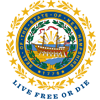PFAS Removal Rebate Program for Private Wells
Funding for eligible private well owners to install a treatment system or connect to a water system.
Program Funding Status – June 10, 2024
The Program is no longer accepting applications until further notice. Applicants with pending applications will be contacted within the upcoming weeks to inform them of their application status.
A second source of funding has been appropriated through House Bill 1547 in June 2022 and per RSA 485-H:9, NHDES is required to adopt rules that govern the Program. While these rules are in progress, they will not be adopted in time for a seamless transition between funding sources. This means that there will be a period of time where application processing will be suspended. We cannot tell you at this time how long the suspension will be, nor if there will be changes to the eligibility requirements for this program. We encourage you check back in to the website for updates and reach out with questions. We will answer them to the best of our abilities. We ask for your patience and understanding during this transition time.
The PFAS Removal Rebate Program provides a one-time rebate of up to $5,000 per residential address to assist in the installation of a treatment system designed to remove PFAS (point-of-use or point-of-entry) or up to $10,000 for a service connection to a public water system. Note: Treatment installations or service connections completed after September 30, 2019, are eligible for this program. Eligibility must be determined through the application process and approval from NHDES to receive a rebate.
ELIGIBLE ENTITIES
The following entities are eligible to apply for the rebate program:
- Owners of a single or multiple-unit residential property.
- Tenants/occupants of a residential property where the owner of the property has not applied for the rebate for the same property.
- Treatment installers may apply in lieu of an eligible owner or tenant with an appropriate waiver of claims between the two parties.
Contracted Treatment Installer Submitted Applications - Applications submitted by contracted treatment installers on behalf of an owner or tenant will not be accepted if the owner or tenant has paid for eligible services rendered. Eligible services must be completed at no cost to the owner or tenant.
FINDING TREATMENT INSTALLERS
Please note that NHDES does not approve or recommend treatment installers for residential wells. It is recommended that owners or tenants obtain quotes from multiple treatment installers. A list of New Hampshire Residential Water Systems Service Providers has been compiled by NHDES. This listing does not imply endorsement by NHDES.
PFAS CONCENTRATIONS FOR ELIGIBILITY
Applicants must be able to provide documentation of PFAS concentrations in their private residential drinking water well above one or more of the US Environmental Protection Agency (EPA) Maximum Contaminant Levels (MCLs) and have no offer of an alternate water source (bottled water, treatment or service connection) from a third party that may be responsible for the PFAS contamination. The EPA has set individual MCLs for five PFAS compounds and a Hazard Index MCL for the mixture of four PFAS compounds. The current EPA MCLs are:
| Compound | MCL in ng/L (nanograms per liter, also expressed as parts per trillion, ppt) |
|---|---|
| Perfluorooctanoic acid (PFOA) | 4.0 |
| Perfluorooctanesulfonic acid (PFOS) | 4.0 |
| Perfluorohexanesulfonic acid (PFHxS) | 10 |
| Perfluorononanoic acid (PFNA) | 10 |
| Hexafluoropropylene oxide dimer acid (HFPO-DA, commonly known as GenX Chemicals) | 10 |
| Mixtures containing two or more of PFHxS, PFNA, HFPO-DA, and Perfluorobutane sulfonic acid (PFBS) | 1 (unitless) Hazard Index |
Please note the above values do not reflect the current NHDES Ambient Groundwater Quality Standards (AGQS) and only reflect eligibility criteria for the PFAS Removal Rebate Program for Private Wells.
DOCUMENTATION REQUIRED
- A completed and signed application form.
- Pretreatment analytical lab results showing concentrations above one or more of the EPA PFAS MCLs – not required if NHDES collected this sample.
- Itemized sales receipt(s)/invoice(s) for all associated work.
- Manufacturer's specification sheets for treatment media and equipment installed, if applicable and available.
- Post-treatment analytical lab results showing PFAS concentrations below the EPA MCLs – not required for water system connections.
- Photo documentation of the treatment installed or service connection.
Did You Know?
Did You Know?
New Hampshire residents using a private residential drinking water well may request to have their water sampled by NHDES for PFAS at no cost by filling out the PFAS Testing for Private Wells Request Form.
For questions regarding the issuance of Form 1099-G related to the PFAS Removal Rebate, please see the information below.
June 10, 2024 – NHDES is no longer accepting applications for the PFAS Removal Rebate Program until further notice. Please see the announcement at the top of this page for additional information.
In order to receive reimbursement from the program, all applicants must register with the New Hampshire Department of Administration (NHDAS) and obtain a Vendor Number. Please refer to the guidance below on how to complete the registration for a Vendor Number.
Additional Resources
- DWGB-3-25 Per- and Polyfluoroalkyl Substances (PFAS) in New Hampshire Well Water (nh.gov)
- A Comparison of Public Water Service to Private Water Wells
- Selecting the Right Option for You: A Guide to Ensuring Safe Drinking Water
- NHDES Be Well Informed Guide
- DWGB 7-3: New Hampshire Residential Water Systems Service Providers
- Laboratory Testing Guidelines for PFAS for Private and Public Drinking Water Supplies
- U.S. EPA Final PFAS National Primary Drinking Water Regulation
- U.S. EPA PFAS National Primary Drinking Water Regulation FAQs
- Final Funding Proposal
Contact Information
PFAS Response Team
pfasrebateprogram@des.nh.gov
(603) 271-8539



